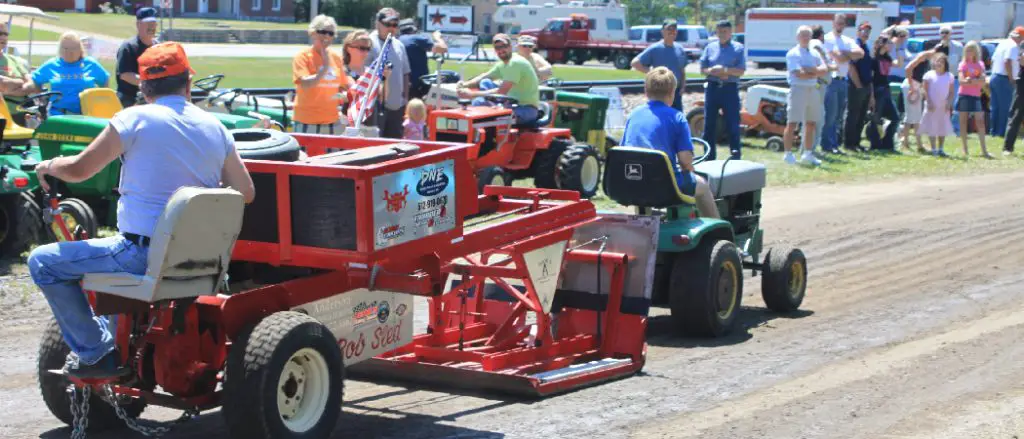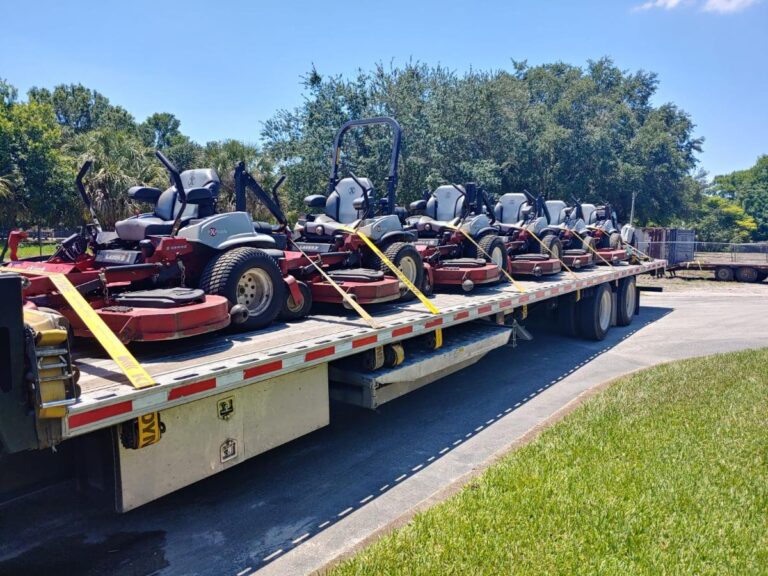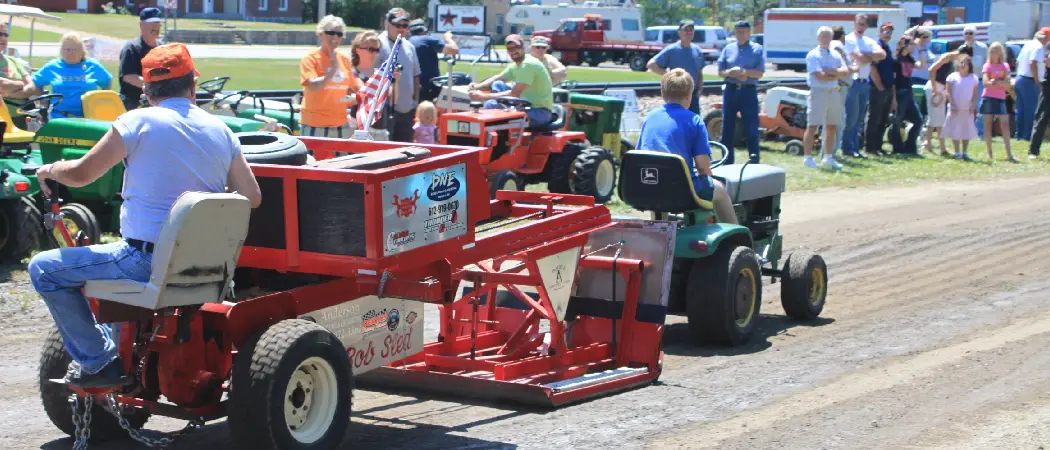To transport a riding lawn mower without a trailer, consider using a truck bed or a hitch carrier. Secure the mower properly for safe transportation.
When you need to transport your riding lawn mower without a trailer, there are several options available. Whether you have a truck with a suitable bed or utilize a hitch carrier, it’s essential to ensure that the mower is securely fastened to prevent any accidents.
Safety should always be a top priority when moving heavy equipment like a riding lawn mower. We will explore different methods for transporting a riding lawn mower without a trailer and offer practical tips to ensure a smooth and secure journey. Let’s delve into the details of how you can transport your riding lawn mower efficiently without the need for a trailer.

Preparing For Transport
As a responsible riding lawn mower owner, preparing for transport is essential to ensure the safety of the equipment and others on the road. Without a trailer, it may seem challenging, but with the right approach, it can be done securely. Taking the time to adequately prepare for transport will protect both your investment in the mower and the safety of others on the road.
Securing Loose Parts
- Inspect the lawn mower for any loose parts, such as knobs, levers, or attachments. Secure these parts with zip ties, bungee cords, or ropes to prevent them from shifting during transport.
- Ensure the mower deck is properly attached and secure. Use tie-down straps to hold it in place, minimizing the risk of accidental engagement during transport.
- Remove and secure the battery to prevent jostling or damage while in transit. Place it in a sturdy, leak-proof container and secure it in the mower’s storage compartment or another safe location.
Checking The Fuel Level
- Before transporting the riding mower, ensure the fuel tank is not completely full to prevent spills or leaks during transport.
- If the tank is full, use a siphon to remove some fuel and bring the level down to around half. This reduces the risk of spills and allows for expansion due to temperature changes.
- After reducing the fuel level, securely fasten the gas cap to prevent any leakage during transport.
By securing loose parts and checking the fuel level, you can ensure a safe and stress-free transport of your riding lawn mower without the need for a trailer.

Securing The Riding Lawn Mower
When transporting a riding lawn mower without a trailer, securely fastening it is crucial to ensure safety and prevent damage. Here, we focus on two important aspects: Using Ratchet Straps and Positioning on the Transport Vehicle.
Using Ratchet Straps
To secure the riding lawn mower, use ratchet straps made of durable material to prevent shifting during transportation.
- Place one end of the ratchet strap around the front axle of the mower.
- Wrap the strap around a secure point on the transport vehicle.
- Tighten the ratchet strap until the mower is firmly in place.
Positioning On The Transport Vehicle
Proper positioning of the riding lawn mower on the transport vehicle is essential for stability and safety.
- Position the mower in the center of the vehicle to distribute weight evenly.
- Ensure the mower is facing forward to reduce wind resistance and enhance stability.
- Secure any loose parts of the mower to prevent damage or loss during transit.
Protecting The Surrounding Area
Safely transport a riding lawn mower without a trailer by using a truck bed or a hitch carrier. Secure the mower with straps to prevent damage and ensure a smooth journey. Protective measures like padding can prevent scratches and maintain the surrounding area.
Avoiding Damage To Landscaping
When transporting a riding lawn mower without a trailer, it is crucial to take measures to protect the surrounding area, especially your landscaping. The last thing you want is to damage the beautiful plants and terrain you’ve worked so hard to maintain. By following a few simple steps, you can ensure that your lawn mower transport is safe and leaves your landscape untouched.
Firstly, before moving your riding lawn mower, you should clear the path of any obstacles that may pose a threat to your landscaping. Remove any large rocks, tree branches, or other debris that could potentially cause damage. This proactive approach will allow for a smooth and uninterrupted journey, minimizing the chances of accidents or unnecessary impact.
Another effective way to avoid damage to your landscaping is by creating protective barriers along the route. Placing plastic or wooden boards strategically on either side of the mower’s path can help shield your delicate plants from accidental collisions. These barriers act as a visual guide and provide a physical shield, preventing any accidental swerves or mistakes that could harm your garden’s greenery.
Minimizing Road Debris
Aside from protecting your landscaping, minimizing road debris is also critical when transporting a riding lawn mower without a trailer. Loose debris such as dirt, grass clippings, or rocks can become airborne during transportation and cause damage to both your mower and surrounding vehicles.
To prevent this, it is advisable to cover your lawn mower with a tarp or durable plastic sheeting. This cover acts as a shield, preventing any loose debris from escaping and causing a hazard on the road. Make sure that the tarp is securely fastened using bungee cords or ropes to ensure that it stays in place throughout the journey.
Furthermore, it is important to regularly inspect the lawn mower for any loose or broken parts that could lead to debris flying off while in transit. For example, make sure the mower’s bag or collection system is properly secured, as it can easily become dislodged when traveling at higher speeds.
By taking these precautions and considering the potential threats to both your landscaping and the road, you can transport a riding lawn mower without a trailer confidently and without causing any harm to the surrounding area.
:max_bytes(150000):strip_icc()/spr-riding-lawn-mowers-test-toro-50-inch-24-5-hp-time-cutter-iron-forged-deck-commerical-v-twin-gas-jodi-espinosa-04-75c8b5328c084eda985d017d68aa32f2.jpeg)
Ensuring Legal Compliance
When transporting a riding lawn mower without a trailer, it is crucial to ensure that you are following local regulations. Understanding the specific laws in your area will not only keep you safe but also prevent any potential fines or legal issues. There are a few key considerations to keep in mind when it comes to legal compliance.
Understanding Local Regulations
Before hitting the road with your riding lawn mower, take the time to familiarize yourself with local regulations regarding transportation of large equipment. Some areas may require a special permit, while others may have specific rules about the types of roads you can travel on. Knowing these regulations in advance will help you avoid any unnecessary complications.
Consider contacting your local Department of Transportation to obtain information about any permits or restrictions that may apply to transporting your lawn mower. They will be able to provide you with specific guidelines that are relevant to your area.
Using Reflective Markings
Using reflective markings on your riding lawn mower is an important safety measure, particularly if you are transporting it without a trailer. These markings help increase visibility, making it easier for other drivers to see your vehicle, especially at night or during adverse weather conditions.
When applying reflective markings, make sure they are strategically placed on all sides of your lawn mower. This includes the front, back, and both sides. By doing so, you are ensuring maximum visibility from all angles. Additionally, it is important to regularly inspect and replace any worn or damaged reflective markings to maintain their effectiveness.
Investing in high-quality reflective tape or decals that meet recognized safety standards is essential. Look for products that are weather-resistant and have excellent adhesive properties. Consider choosing bright colors like yellow or orange to ensure maximum visibility.
Remember, the use of reflective markings should not replace other safety measures like using hazard lights or utilizing proper signaling when turning or changing lanes. They should be seen as an additional precautionary measure to enhance the visibility of your riding lawn mower.
Weather Considerations
When transporting a riding lawn mower without a trailer, it is important to consider the weather conditions to ensure the safety of both the operator and the equipment. Rain or wind can pose potential risks during transportation, requiring proper preparation and precautionary measures.
Securing Against Rain Or Wind
Transporting a riding lawn mower without a trailer exposes the equipment to the elements, particularly rain and wind. To protect your riding lawn mower from rain, it is essential to use tarps or covers specifically designed to shield against water. Make sure the tarp is securely fastened and fully covers the mower to prevent any water damage. Additionally, if you anticipate strong winds, it is advisable to secure the tarp with bungee cords or straps to prevent it from being blown away.
Planning For Adverse Conditions
Unpredictable weather conditions can pose significant challenges when transporting a riding lawn mower without a trailer. Therefore, it is vital to plan ahead and be prepared for adverse conditions. Check the weather forecast before transporting your mower and avoid transporting it during heavy rain, thunderstorms, or strong winds. If unexpected weather changes occur while transporting, seek shelter if possible or find a safe area to temporarily park and protect your equipment until the weather improves.
Furthermore, it is crucial to inspect the route beforehand to identify any potential obstacles or hazards that may worsen in certain weather conditions. For example, if there are steep hills or slippery surfaces on your intended route, it is best to delay the transportation until the conditions are more favorable. Ensuring a smooth and safe journey for both you and your riding lawn mower is of utmost importance.
Alternative Transport Options
When it comes to transporting a riding lawn mower without a trailer, there are alternative transport options that can be utilized. Whether you need to move your mower for maintenance or landscaping purposes, these innovative methods can offer a solution when a trailer is not available. Let’s explore some alternative transport options for moving a riding lawn mower efficiently and safely.
Utilizing Truck Beds
For transporting a riding lawn mower without a trailer, utilizing a truck bed can be a practical solution. Securely loading the mower onto the truck bed and using appropriate tie-down straps is crucial to ensure the safe transport of the equipment. Place the mower strategically to distribute the weight evenly and prevent any unbalanced movement during transportation. Prior to loading, it’s important to measure the dimensions of the truck bed and the mower to ensure a proper fit.
Renting A Tailgate Ramp
Renting a tailgate ramp is another option for transporting a riding lawn mower without a trailer. These ramps are designed to facilitate the loading and unloading of heavy equipment, including riding lawn mowers, into a truck bed or onto a trailer. When renting a tailgate ramp, it’s important to select one that can accommodate the weight and size of your mower, ensuring a safe and secure transition. Additionally, following the user manual for the tailgate ramp and practicing loading and unloading in a safe environment is imperative to avoid accidents during transport.
Safety Precautions
Moving a riding lawn mower without a trailer requires careful attention to safety precautions to ensure the safety of both the operator and other road users. Adhering to these safety measures can prevent accidents and damage to the equipment.
Inspecting The Transport Vehicle
Before loading the riding lawn mower onto a transport vehicle, it’s crucial to thoroughly inspect the vehicle for any signs of wear and tear that could compromise its ability to securely hold the mower in place.
Wearing Personal Protective Equipment
When moving a riding lawn mower without a trailer, it is essential to wear personal protective equipment (PPE) such as work gloves, eye protection, and sturdy footwear to safeguard against potential hazards during the transport process.
:max_bytes(150000):strip_icc()/spr-riding-lawn-mowers-test-toro-50-inch-24-5-hp-time-cutter-iron-forged-deck-commerical-v-twin-gas-jodi-espinosa-04-75c8b5328c084eda985d017d68aa32f2.jpeg)
Arrival And Unloading
Upon arrival and unloading, releasing straps and securing devices is crucial.
Releasing Straps And Securing Devices
First, release the straps and securing devices carefully.
Carefully Guiding The Mower Off The Transport Vehicle
Guide the mower off the transport vehicle with caution.
Frequently Asked Questions Of How To Transport A Riding Lawn Mower Without A Trailer
What Is The Easiest Way To Transport A Riding Mower?
The easiest way to transport a riding mower is by using a utility trailer or a truck with a ramp. Ensure the mower is securely tied down. If using a trailer, drive cautiously and adhere to all road safety guidelines.
Will Riding Mower Fit In Truck Bed?
Yes, most riding mowers will fit in a truck bed. Make sure to measure the dimensions and consider the weight for safe transport. Secure the mower with straps or tie-downs to prevent shifting during transportation.
Can You Lift A Riding Mower Into A Truck?
Yes, it is possible to lift a riding mower into a truck. However, it requires caution and proper technique to avoid injury or damage to the mower and truck. It is recommended to use ramps, straps, and assistance from others to safely load the mower into the truck bed.
How Do You Move A Riding Lawn Mower?
To move a riding lawn mower, simply engage the brake, turn off the engine, and release the cutting blades. Use the gear shift to put the mower in neutral, then push or tow it to the desired location. Always follow safety guidelines while moving the mower.
Conclusion
Transporting your riding lawn mower without a trailer is possible with these simple tips. By using a truck bed or hitch carrier, you can easily move your mower around. Remember to secure it properly to avoid any accidents. Happy mowing!

